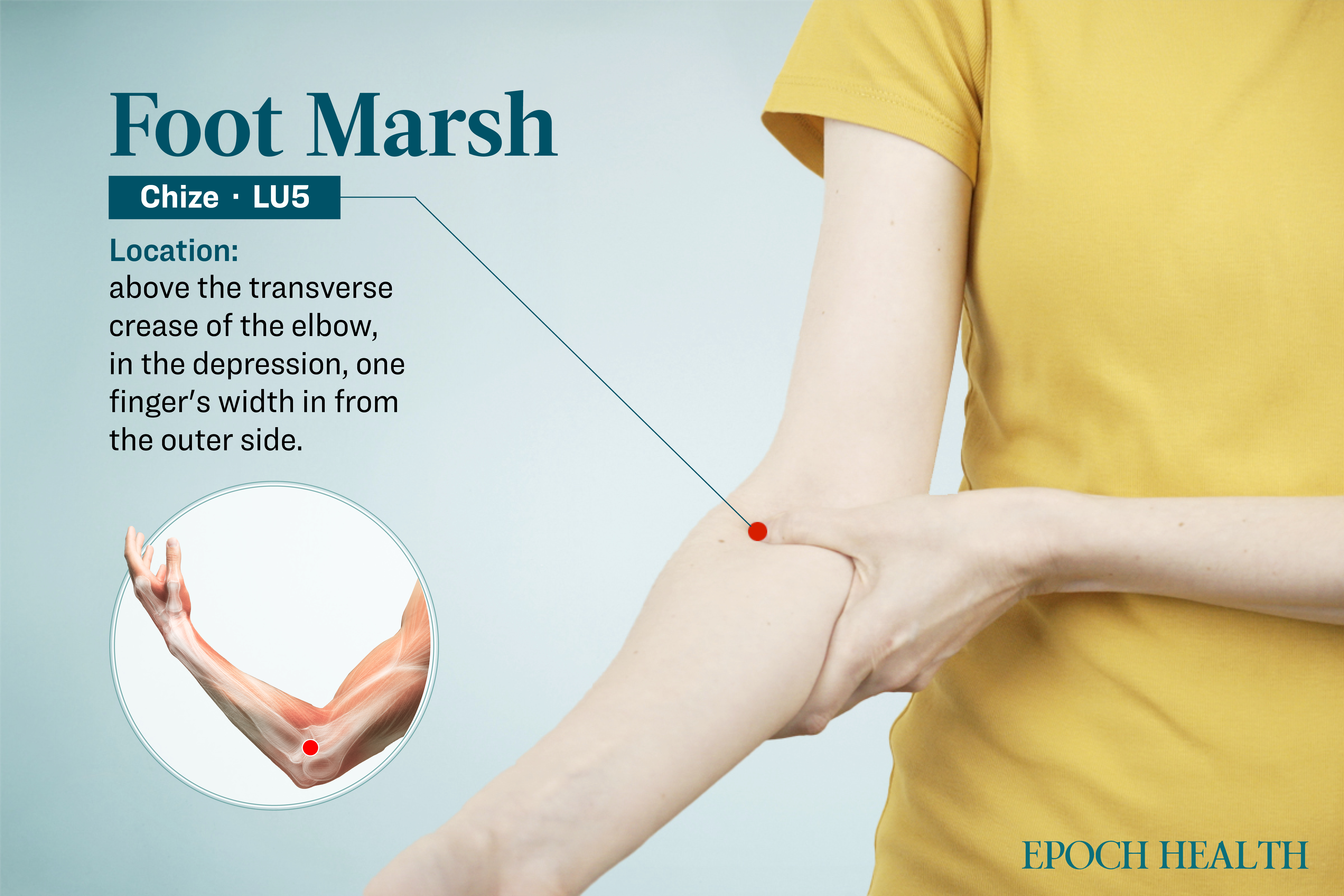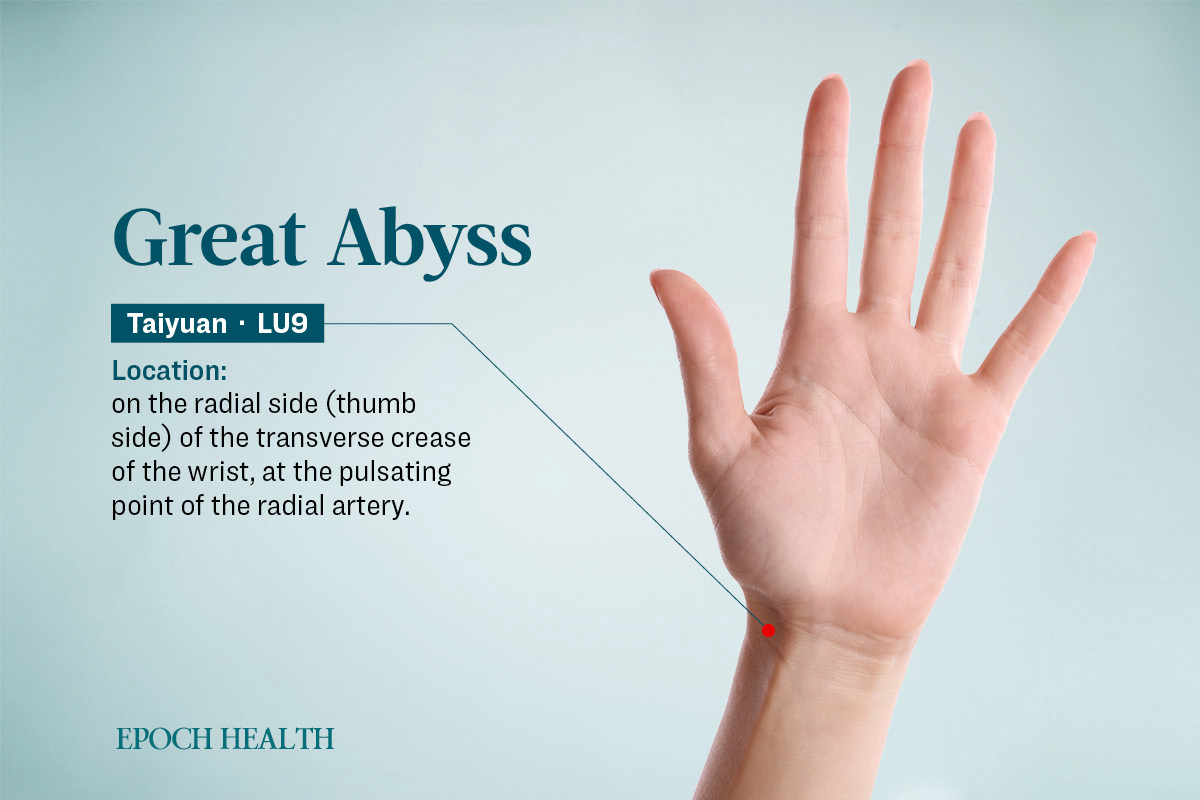Health Viewpoints
Wheezing and coughing are common respiratory nuisances that are more likely to occur when the weather or environment changes. There are ways to treat asthma through specific acupoint massaging and diet to alter the constitution of those with asthma and help them better manage and prevent the disease.
According to traditional Chinese medicine (TCM), asthma can be segregated into “heat asthma” and “cold asthma,” and TCM practitioners will determine what it is based on the pulse and symptoms. Most people with heat asthma have yellow phlegm, elevated body heat, and fever. They often cough heavily and have red faces and swollen necks. Some even exhibit bad tempers as a result. In this situation, improvement can be made with “cold-natured” medicine or food.
Cold asthma occurs more commonly in wintry weather or when temperatures fluctuate widely, and the phlegm is mostly white and foamy. In this case, warm foods are used for treatment.
From a TCM perspective, most foods or medicinal herbs are either “cold” or “hot” in nature and are usually divided into three groups: cold, hot, and warm (neutral).
Why the Wheezing Sound of Asthma?
When the trachea narrows, it’s difficult to breathe, creating a wheezing sound. When the trachea is inflamed, the cilia along its inner wall touch each other. The body sees this action as having foreign bodies, resulting in the cilia moving vigorously and causing the trachea to feel itchy. When the cough becomes severe, a wheezing sound will occur.
Massage 2 Acupoints to Treat Asthma
The “Zi Wi Liu Zhu (meridian circulation)” concept in TCM could also be promising for treating asthma. TCM believes that the 12 meridians, (pathways of vital energy) of the human body follow specific schedules and paths, each corresponding to one of the 12 traditional Chinese time periods in a day. Within each of the 12 time periods, the qi and blood on the corresponding meridian will become particularly abundant, and the organs governed by that meridian will be more active. At the same time, the acupoints on the same meridian also become more responsive, enhancing the effectiveness of acupuncture treatments during these times.
Between 3 and 5 a.m., qi flows primarily through the lung meridian. People with lung issues often cough more severely during this time. Agitation through acupuncture or massaging the acupoints on the lung meridian at this same time is also the best time to treat asthma and other lung-related diseases efficiently.
If an asthma attack occurs between 3 to 5 a.m. when lung qi is at its most prominent, and medical attention may not be immediately available, pressing the “Chize point” can relieve cough, reduce phlegm, and improve asthma. If an attack happens around 5 to 7 a.m., when lung qi begins to decline, pressing the “Taiyuan point” can replenish lung qi, benefit the heart, relieve cough, and reduce phlegm.
By massaging these two acupoints at two different periods of time, it can effectively treat asthma.
Cold Drinks Induce Asthma
During hot months, many people drink ice water or take cold showers to cool down, which may trigger asthma.
A Case Study
More than 30 years ago, a mother brought her child to my office. Every time the child inhaled, he needed to close his eyes, lift his shoulders, and push his belly upwards.
It is recorded in the ancient Chinese medicine classic “Treatise on Cold Damage Diseases” that drinking too much or icy water after sweating can lead to asthma. This patient often drank cold water after sweating during exercise. So, I prescribed “Ephedra, Almond, Licorice, and Gypsum Decoction,” and he recovered after taking two doses.
Ephedra is often prescribed to treat colds, bronchial asthma, nasal congestion, and other diseases.
Almonds are widely used to treat respiratory diseases like cough, wheezing, asthma, emphysema, and bronchitis. Licorice is commonly applied in TCM to relieve cough and expectoration. As an herbal remedy for sore throat, the triterpenic acid in licorice can protect bronchial epithelial cells and reduce apoptosis, oxidation, and inflammatory stress.
Gypsum is a TCM herb renowned for its heat-clearing and fire-draining properties. Gypsum has demonstrated anti-inflammatory effects, which are beneficial in reducing inflammation associated with heat-related conditions. Studies indicate that calcium ions in gypsum can modulate immune responses, contributing to its anti-inflammatory action.
Steamed Pears to Treat Asthma and Cough
Steamed pears can benefit people with asthma. A delicious pear steamed with rock sugar and almonds is effective against coughs. Either yellow or green pears are fine for this purpose.
In China, pear paste (concentrated pear juice) has been used to treat respiratory diseases such as cough and sputum for more than 1,000 years. Bulbus fritillariae cirrhosae is one of the most used Chinese medicines for lung disease, and exerts antitussive, expectorant, anti-inflammatory, anti-asthmatic, and antioxidant effects.
“Lily, Tremella, Lotus Seeds, and Red Dates Soup” made from lilies, white fungus, red dates, and lotus seeds can also improve the body constitution prone to coughing and asthma.
People with asthma should avoid eating “cold” foods like bananas, oranges, duck meat, ice-cold treats, etc. When coughing or wheezing has already started, water apple, watermelon, mango, pineapple, and cantaloupe should also be avoided. Otherwise, the trachea may continue to contract, leading to non-stop wheezing.
Cold Air Is Another Allergen
Chilly air is also an allergen that can trigger asthma. A long-time neighbor of mine used to loudly wheeze in the morning and evening because he was allergic to chilly air.
For centuries, TCM has used “Xiao Qing Long Tang (XQLT)” to treat asthma. The ancient Chinese medicine book “Treatise on Cold Damage Diseases” records that removing Ephedra and adding apricot kernels to Xiao Qing Long Tang can effectively treat asthma. In clinical practice, I frequently use this formula, but I recommend it be taken under the guidance of a physician.
Studies have found that XQLT exhibits anti-airway inflammation, anti-airway remodeling, and specific immunoregulatory effects in a chronic asthmatic mice model.
Si Jun Zi Decoction Nourishes Spleen, Lungs for Wheezing
The best way to make yourself less vulnerable to wheezing is to make sure you have built sufficient resistance. Asthma is most often related to the lungs, spleen, and kidneys, of which the lungs are worth the most attention. TCM’s Five Elements Theory sees the spleen as the mother of the lungs and the kidneys as their sons.
TCM says, “When faced with deficiency, nourish the mother; purge the child if in excess.” Put into practice here, it becomes: If it is a qi deficiency condition, the lungs should be treated by nourishing the spleen; if it is an excess condition, the lungs should be purged by nourishing kidney qi.
If you want to replenish the spleen and lungs, there is an efficient prescription called “Chuan Si Jun Zi Decoction. ” However, due to the agarwood it contains, it’s relatively expensive. The prescription should be used under the guidance of a physician.
Note: The Chinese herbal medicines mentioned in this article can be purchased in health food and Asian grocery stores. Since everyone’s constitution is different, please consult a professional physician for specific treatment plans.
Views expressed in this article are the opinions of the author and do not necessarily reflect the views of The Epoch Times. Epoch Health welcomes professional discussion and friendly debate. To submit an opinion piece, please follow these guidelines and submit through our form here.



